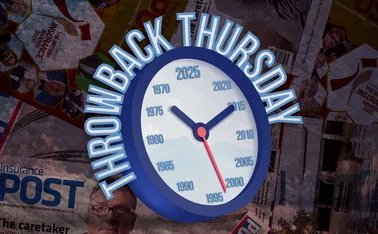
Analysis: 'Dangerous excesses' - Rogue firms drive increase in six-figure credit hire claims

Need to know
- Keoghs estimates that a rise in the value of credit hire claims cost insurers an extra £50m in 2018.
- Over the past two years Keoghs has seen an increase in the rise of credit hire fraud where individuals stage or induce an accident for the purposed of somebody claiming for whiplash.
- Firms including Keoghs, Dac Beachcroft, BLM and DWF all seen increase in claims over or equal to £100,000.
The value of credit hire claims is increasing by approximately up to £100 each year as "outlier" companies leave insurers increasingly dealing with claims in excess of £100,000, lawyers have cautioned.
Recently Keoghs successfully defended Aviva in a case involving a £400,000 credit hire claim. The credit hire firm that had arranged the replacement vehicle, Direct Accident Management, is not a member of the Credit Hire Organisation.
With approximately 500,000 credit hire claims in the UK every year, Keoghs estimates that a rise in the value of credit hire claims cost insurers an extra £50m in 2018.
Companies that sit outside of the General Terms of Agreement, which account for 15% to 20% of the market, are contributing to the increase, according to John Gibson, partner at Keoghs,
While the average value of claims handled within the GTA space is about £1400, Gibson added that costs are significantly higher for claims handled outside the agreement.
Currently, Keoghs has 20 vehicle hire claims over £100,000 and a further four claims over £200,000 on the go.
Gibson explained that some firms use a business model that charges high daily rates and aim to target people who are “in [difficulty] and do not have money to hire vehicles themselves”.
He said there is “something wrong with our system where that can be allowed to happen”.
He added: “There are some dangerous excesses in the market where I actually feel the claim is potentially being used for the gain of a company.”
Over the past two years Keoghs has seen an increase in the rise of credit hire fraud where individuals stage or induce an accident for the purposed of somebody claiming for whiplash.
He said: “The whiplash claim would be maybe £2000, but we are going to be at the point where whiplash in effect is going to be worth considerably less, you’ve got credit hire on the other side that is worth the exact same amount.”
“In addition to that, we have still got a market for referral fees for existing credit hire, so there are movements around money in the supply chain.
“Over the last 12 months, we repudiated circa £3m worth of claims and paid pretty much zero where we have believed that hire element of the claim was fraudulent. For example, if it didn’t happen at all or steps were taken to increase the damage to the vehicle to make it unroadworthy and things of that nature.”
Significant claims
Keoghs is not the only law firm that has seen an increase in the value of credit hire claims, with others reporting claims of significant amounts.
Gavin Perry, partner at DWF and a specialist in motor fraud said: “We have dealt with a considerable number of claims where the hire charges exceed £100,000. In cases where the accident damaged vehicle is a Ferrari and costs £1500 per day to hire, that might be understandable. But in many cases the vehicles involved in the accident are low value cars and motorbikes, where the claimant is alleging impecuniosity [having very little or no money].”
“A recent example was a motorcycle claimant who was still hiring two years after an accident where he took a driver improvement course to avoid prosecution for riding without due care and attention – the hire charges were £160,000 and continuing. The motorbike damaged in the accident was worth £1,300, and the motorcyclist’s insurer had paid the claim of the individual against who the claimant was claiming.”
Perry added that another area where he has noticed claims over £100,000 is for the hire of taxis.
He said: “I have seen daily hire rates of £650 where the claimant’s declared net profit per day doesn’t exceed £30.”
“A decision to incur so much, to earn so little is economic folly,” he added.
Perry called on claimant solicitors, the credit hire firms and claims management companies to be “mindful of the obligations placed upon them” by the Solicitors Regulation Authority and Financial Conduct Authority.
He said: “That is particularly relevant where the constituent companies are all part of an overarching holding company, and may mean that advice on mitigation of loss is detrimental to the ‘written invoices’ of another part of the business.”
“Double digit” increase
DAC Beachcroft has seen a double digit increase in claims equal to or over £100,000 over the last 12 months and reported a 10% rise in the amounts claimed, Emma Fuller head of credit hire confirmed.
She said: “The team is currently handling a couple of claims in the region of £250,000, and regularly sees them over £100,000.
“In addition to seeing an increase in the value of genuine credit hire claims across the market, there is also an alarming increase in the value and volume of credit hire claims in the non-volume and credit hire fraud arena.”
While there are many reasons why the insurers might not release a cheque straight away, many credit hire companies will take the claimant out of credit hire otherwise the costs will go up and up.
However, some companies will keep the claimant hiring for months. This often happens when insurer is unable to release a cheque due to liability dispute or fraud concerns, according to Sarah Cartlidge, member of the Forum of Insurance Lawyers and partner at BLM.
She said: “The reputable companies effectively don’t like to see these pictures, because the bigger the cost the bigger the risk for them that they might not recover it.”
“The over £100,000 cases used to be rarity, where now they are a little bit more frequent,” she added.
Cartlidge said: “Looking at some of the statistics for the hire claims and the average hire claim amount, you could certainly say that there is an increase in the value of claims.”
Outliers
Members of the Credit Hire Organisation are not responsible for ramping up credit hire costs, the body told Post.
A spokesperson for the CHO said: “The number of accidents every year is coming down in number every year. In terms of credit hire elements, the truth is that credit hire companies operate at very thin margins and under the terms of the recently signed GTA, the charges made to credit hire companies has fallen by 5%.
“So it seems odd that in an environment where credit hire fees have come down by 5% and there are fewer accidents that there’s such discrepancy.
“Our members are highly reputable and most of them are regulated by the FCA. They have good and trusted relationship with their insurers partners. However, there are credit hire companies, just as there are law firms and insurers, that sometimes don’t necessarily subscribe to the rules and the way of doing business that our members do at the CHO.
“In any industry there are outliers. There are businesses that don’t play by the rules and that applies to credit hire and it applies to insurance and it applies to law.
“There will be outliers that perhaps bend the rules. As far as our members are concerned, the whole point about the CHO is we stick by the rules, we have good quality arrangements with the insurers that we work, and our member companies are responsible for the vast proportion of the market.
“As far as we are concerned, we do a straightforward and honest job. It’s in our interest to do so and it’s in our interest to turn higher ground as quickly as possible, and it’s in our interest to have good working relationship with our partners.
“There may be one or two companies that do bend the rule but they certainly won’t be among our members.”
Case study: A six-figure credit hire claim
Last week Keoghs, on behalf of Aviva, defended a £400,000 credit hire claim for a replacement vehicle hired by a claimant over two years ago.
The claim related to a car accident that happened on 27 December 2016 on Blake Street, Sutton Coldfield between two cars: an Audi driven by the claimant Susan Clare Harries, and a Honda that belonged to defendant Kevin John Baguley.
While the accident happened two years and 9 months ago, Harries is still hiring a replacement vehicle and has done so throughout the period. The claimant claimed that the accident was the fault of the defendant, because he reversed out into the road and into collision with her car when it was unsafe to do so.
Meanwhile, the defendant claimed that the accident was solely the fault of the claimant because his car was stationary at the side of the road and he was not in the vehicle at the time of the accident.
In her written and oral evidence, Harries described how she was driving along Blake Street at 35mph – the speed limit on that section of the road being 40mph.
She said that as she drove along, she saw a stationary car on her nearside, parked partly on the pavement and partly on the road. It had lights on. However as she went to pass the stationary car, the defendant’s Honda “reversed out from the left-hand side, directly into my path”. She added that she had no time to avoid the collision.
The judge, Recorder Edis QC, pointed out that one of the photographs of the car taken at the scene shows that claimant’s offside front windscreen was clear, the offside front window was obscured and there was some obstruction to visibility through the front nearside windscreen. Meanwhile, Baguley was insistent he parked his car “half on, half off” the pavement to inspect the tyres.
He stated that while he was inspecting the rear nearside tyre the car was hit by the Audi. He said that he had not seen the approach of the other car, for example, headlights, nor had he heard its engine.
He said that after the accident he had checked on his family and went to see the claimant who was still in their car.
After reviewing the evidence from both the claimant and the defendant the judge at the Nottingham County Court found that the defendant “had indeed parked his car lawfully at the side of Blake Street to examine its tyres” and he was not in the car at the point of impact.
The judge also found that the claimant drove “into it through negligent driving”. He said: “I do not need to find an explanation for this, for all most drivers are from time to time inexplicably careless, but I suspect that her view was not as clear as she claims it was.”
He added that the defendant bore no blame for the accident. He ruled the costs to be recovered from the claimant, aside from the hire charges for which she is responsible. He concluded: “I invite the parties to agree on costs and any consequential directions for the trial of quantum in the part 20 claim. If they agree I will incorporate such agreement in the Court’s order.”
Richard Hiscocks, director of casualty claims at Aviva, said: “This is one of the most astonishing credit hire claims we’ve seen in some time, and highlights just how far credit hire organisations are willing to go to pursue profit at the expense of honest customers.
“This case highlights an important issue as to whether claimants should bear some responsibility for mitigating their losses. In this instance, we paid the excess on a without prejudice basis to enable the claimant to mitigate their loss. This offer was rejected, which ultimately led to the £400,000 hire invoice, plus costs, for which the claimant could now be personally liable.
“Challenging cases where costs have escalated out of all control is the right and responsible thing for us to do. We have a responsibility to our premium paying customers to keep our costs low, which ultimately helps reduce pressure on insurance premiums.”
John Gibson, partner at Keoghs, said: “This case highlights real concerns for insurers and motorists more widely. A claim where liability was strongly denied, and repeatedly communicated from the outset has been presented for an astronomical sum, for which the claimant is ultimately liable. Genuine attempts to assist in mitigation were declined, such as to pay for the claimant’s policy excess to enable them to utilise their own comprehensive policy. Such cases can only serve to increase premiums for all motorists and steps must be taken by all involved in the industry to prevent other such claims in future.”
Direct Accident Management did not respond to a request for comment.
Only users who have a paid subscription or are part of a corporate subscription are able to print or copy content.
To access these options, along with all other subscription benefits, please contact info@postonline.co.uk or view our subscription options here: https://subscriptions.postonline.co.uk/subscribe
You are currently unable to print this content. Please contact info@postonline.co.uk to find out more.
You are currently unable to copy this content. Please contact info@postonline.co.uk to find out more.
Copyright Infopro Digital Limited. All rights reserved.
As outlined in our terms and conditions, https://www.infopro-digital.com/terms-and-conditions/subscriptions/ (point 2.4), printing is limited to a single copy.
If you would like to purchase additional rights please email info@postonline.co.uk
Copyright Infopro Digital Limited. All rights reserved.
You may share this content using our article tools. As outlined in our terms and conditions, https://www.infopro-digital.com/terms-and-conditions/subscriptions/ (clause 2.4), an Authorised User may only make one copy of the materials for their own personal use. You must also comply with the restrictions in clause 2.5.
If you would like to purchase additional rights please email info@postonline.co.uk








